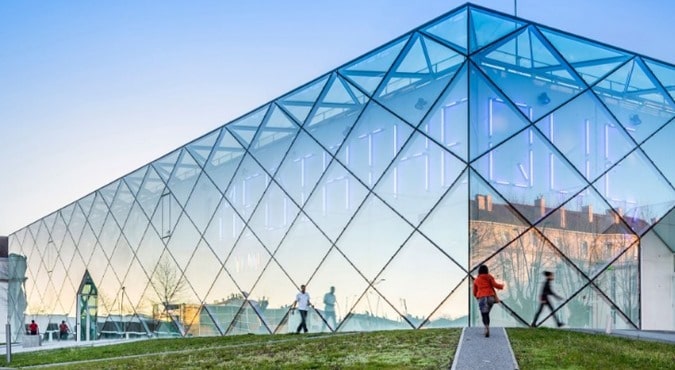Sheet Glass is used for glazing doors, windows and partitions and is obtained by blowing the molten glass into the shape of a cylinder. The ends of the cylinder so produced are cut away and the cylinder is flattened over a plane tray. It is available in thicknesses of 2, 2.5, 3, 4, 5, 5.5 and 6.5 mm and up to 1750 × 1100 mm size.
Plate Glass is used for all engineering purposes and is superior to sheet glass. A plate glass differs from a sheet glass in that it has a parallel, distortion-free surface obtained by grinding or floating process. It is produced by pouring the molten glass on casting tables and levelling it to an uniform thickness. Both the glass surfaces are then ground, smoothened and polished. Glass so produced is clear and contains unblemished true plane surfaces and is available in thicknesses of 3 to 32 mm and sizes up to 2750 × 900 mm
Tempered Glass is made from plate glass by reheating and sudden cooling and is 3 to 5 times stronger than plate glass. Although not unbreakable, it resists bending stress better than plate glass and, when broken, the pieces are relatively small in size. It is used extensively in sports arenas, sliding doors and curtain walls.
Wired Glass is produced by embedding wire nets 0.46 to 0.56 mm into the centre of sheet glass during casting. The minimum thickness of wired glass is 6 mm. When broken it does not fall into pieces. It has higher melting point than ordinary glass.
Wired glass is used for fire resisting doors and windows, for sky lights and roofs. A special example of this is wired-refrax glass which transmits 100 per cent more light than the other glasses.
Obscured Glass is made comparatively opaque to sunlight. Also known as patterned glass. They are classified as frosted, rolled and ribbed.
Frosted glass is produced by subjecting the polished face of the glass to a sand blast which grinds off the surface. It can also be produced by etching on glass by hydrofluoric acid.
Rolled glass has a series of waves of desired pattern on the surface and is also known as figured rolled glass.
Ribbed glass A series of triangular ribs are produced in the glass during casting.
Laminated Glass is made by sandwiching a layer of polyvinyl butyral between two or more layers of plate or sheet glass. It is also lso known as safety glass. The examples are heat proof glass, sound proof glass and bullet proof glass.
Heat and sound proof glasses Two or more glass plates are sandwiched by a tinted plastic inner layer. It provides high resistance to heat and glare. By increasing the thickness of plastic layer the glass can be made more sound resistant.
Bullet proof glass is produced by placing vinyl plastic and glass in several alternate layers and pressing them with outer layers of glass. It is used in banks, jewellery stores and display windows.
Insulating glass is composed of two glass plates into which a layer of 6–13 mm thick dehydrated air is sealed. The round edges are formed by fusing together the two glass plates. These glasses reduce the heat transmission by 30–60 per cent.
Heat absorbing Glass is bluish green in colour and cuts ultra violet rays of sun. The example is calorex. It is used in railway carriages, factories, hospitals, health clubs and kitchens.
Ground Glass In this type of glass one face of plate or sheet glass is made rough by grinding. It is used for maintaining privacy by obstructing vision and at the same time allowing light. The ground glass is used for bedrooms, toilets and for making black boards.
Block Glass is hollow sealed made by fastening together two halves of pressed glass. It is used for making partitions.
Coloured Glass is produced by adding oxides of metals to molten glass:
Opal Glass is also known as milk glass. It is produced by adding bone ash, oxide of tin and white arsenic to vitreosil (99.5% silica glass known as clear silica glass). The composition is 10 parts of sand, 4 parts cryolite and 1 part zinc oxide.
Enamel Glass is produced by adding calcined lead and tin oxide to the ordinary glass. The composition is 10 parts sand, 20 per cent lead and tin oxide and 8 parts potash.
Optical Glass contains phosphorus, lead silicate and a little cerium oxide, the latter capable of absorbing ultraviolet light injurious to eyes. They are used for making lenses.
Commercial Forms of Glasses
![Commercial Forms of Glasses]() Reviewed by SANTHOSH KUMAR
on
August 07, 2018
Rating:
Reviewed by SANTHOSH KUMAR
on
August 07, 2018
Rating:







No comments: